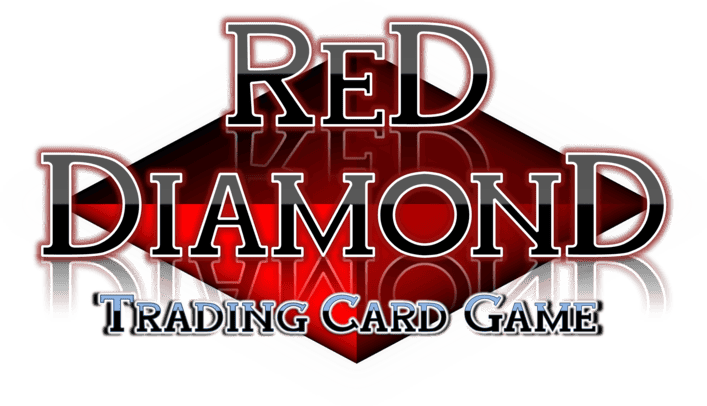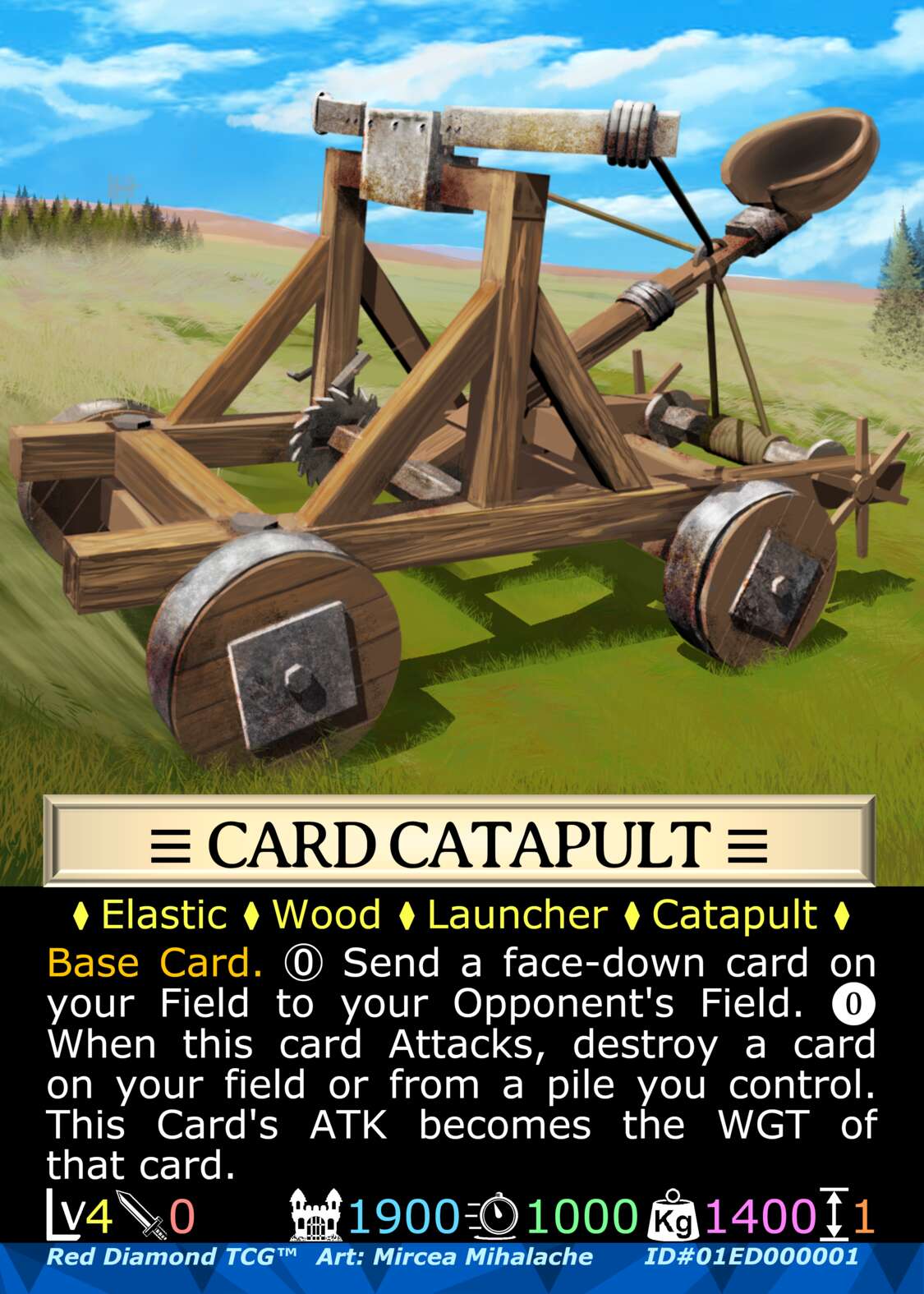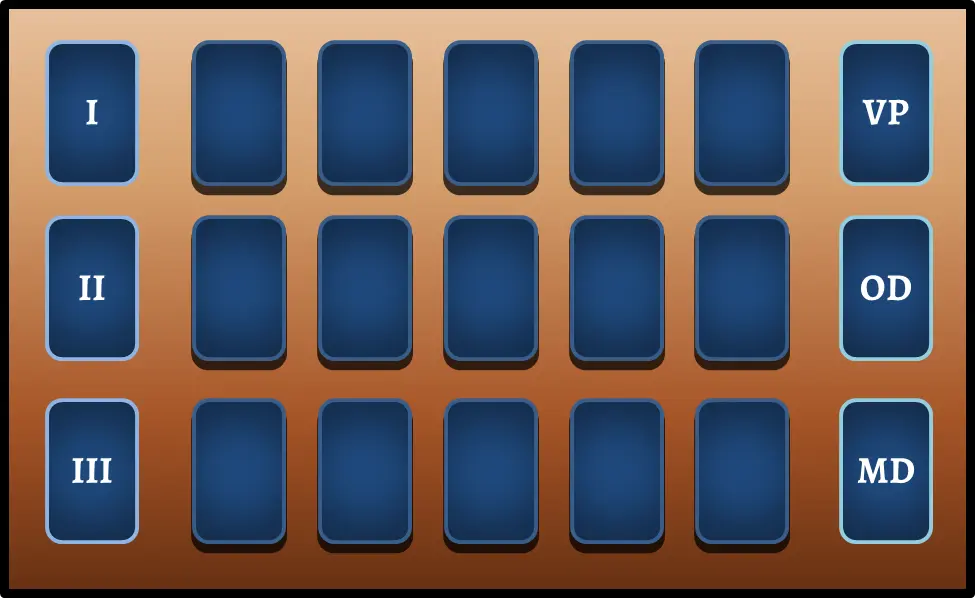
Welcome to the Red Diamond Trading Card Game™. In this game, you will use all manner of creations to out-play your Opponent in this war of wits, and claim Victory! Everything you need to start playing with comes in this Starter Pack. Collect additional cards to improve and personalize your Deck, and discover all-new play styles!
This is the official Red Diamond rulebook. If you’re a new player, try to keep this handy; it will help guide you through your first few games.
To win a game of Red Diamond you must:
To play a game of Red Diamond, you’ll need:
Here is a look at a typical Base Card. These cards make up the majority of the cards in your deck, and are used to help score your Victory Point cards. Base cards have a blue bottom-border, while VP cards have a red one:

Each card comes with its own unique artwork depicting the “real-world” object(s) that the card represents. Card Art is purely aesthetic and has no bearing on the rules or outcome of the game; however, cards can have multiple official published artworks by talented artists, from different print runs. Collect the ones that you like best!
The Card Name is always found between the two “≡” symbols, right above the card’s main text box. During the game, players shall refer to cards by their official card name as it is written on the card (with a little wiggle-room for pronunciation). Multiple copies of cards (with the same name) are not allowed in your Deck.
Attributes physically describe the real-world features of the object that the card represents. A card’s Attributes can always be found as the first line of text between “⧫” Symbols. When Attributes show up in card text, they are found in quotes (“ ”). When multiple Attributes for a card are listed in a row, only those specific cards that contain all of those attributes (presented in any order) count for the purposes of that card effect.
The main part of the card’s textbox is dedicated to your card’s effects and play conditions. Play conditions always show up first; these must be followed each time you play this card. Second, comes your VP scoring conditions (on VP cards only). Lastly, all of your card effects are listed (see
A card’s Level, Attack (ATK), Defense (DEF), Speed (SPD), Weight (WGT), and Height (HGT) are all considered card “Stats”. Stats are always found at the bottom row of every card. Cards with missing Stat information (left-blank) cannot be affected by card effects that refer to that information, (unless the card effect specifically gives that card a Stat). Cards without Stats are actually some of the most powerful cards in the game!
A card’s level represents the “apparent” power of a card. Don’t be fooled, though: low-level cards can still be very powerful and versatile. A card’s level is always found at the bottom-left corner of the card.
This Stat represents the destructive potential of the card. Having this Stat allows you to declare an Attack (see
This Stat represents how tough the object on the card is. It is usually better if your card doesn’t have this Stat, because then, it can’t be targeted for Attacks. Usually, though, you’ll want a high Defense for it to last a long time on the field!
This Stat represents how fast the object reacts or moves in the field. Faster cards can sometimes give you an edge in gameplay, depending on card effects.
This Stat generally represents how heavy the object on the card is. Almost every card in the game has this Stat; meaning that this is the most consistent Stat to use for targeting Card Effects.
This Stat generally represents how large, tall, or high up the object is on the field. If your card’s Height is 2 or more levels greater than another card on the field, that card cannot affect or target yours. The HGT stat of any card or pile in the game is always limited to 7. Card height becomes very important in advanced play (see

On your Playmat there are seven (7) distinct zones of play. Cards on your playmat are the cards that you control:
The zones may be mirrored left-right (horizontally) to accommodate left-handed players.
At the beginning of the game, you will separate out your cards so that the Main Deck comprises of everything except your Victory Point Cards. The Main Deck serves as the Player’s hand, where you can directly pick-out and choose the cards that you would like to play. You may organize, rearrange, or shuffle the cards within your Main Deck at any point. Whenever you are not using your Main Deck, it should be placed face-down at the bottom right hand corner of your play-area (see
At the beginning of the game, your Open Deck is made up of all your Victory Point Cards, but will grow to include the majority of your Deck by the end of the game. The Open Deck is always placed directly above the Main Deck on the Playmat (see
The Victory Pile is always found directly above the Open Deck on the Playmat (see
Although the general wisdom with VP cards, is to “score” your VP cards, as soon as possible; Players who hold-off scoring their individual cards can increase their score by scoring several cards together in “Sets”.
Your field is comprised of 15 “open spaces” (3 Horizontal Rows, and 5 Vertical Columns) where you can play your cards. Base Cards on your field can be used to battle, activate card effects, and help fulfill your Victory Point conditions. Victory Point cards also require being on the field while their VP conditions are being met. By definition, you control the cards on your field. When you “steal” or “give” away cards, those cards move to the opposite side of the field (always facing their original owners) to express that change in control. In card text, “the field” refers to both sides of the field: both your and your Opponent’s field.
There are 3 Recycle Piles: “The First” (I), “The Second” (II), and “The Third” (III). Discarded cards go to the First Pile, unless otherwise noted. At the beginning of your turn, the Recycle Piles slide to the next consecutive pile, in this sequence:
When you control an Opponent’s card (see
All face-up cards in this game are considered “public information”, meaning that at any point during the game, players may ask to see and read these cards. Upon request, a player may pass their Opponent a single card or the entire deck or pile. After reviewing, the card(s) must be put back in the same location. When a player is asked a question that involves Public Information (like how many cards are in a pile on their field), their Opponent must answer truthfully and accurately.
Mistakenly showing a card, during gameplay, either by dropping a card or by accidentally playing an Action when the conditions cannot be met, replaces that Action with the “Reveal” Action (from your Main Deck) or “Flip” Action for face-down cards on your field.
At the beginning of your turn, you always start with five (5) Action Points (AP). AP are used to pay for card effects and perform Actions, during the game. AP can be actively used during your turn or defensively during your opponent’s turn. You lose any remaining APs that you haven’t used at the end of your Opponent’s turn.
Here are some Actions you can perform on your turn, for free:
Special Actions cost one (1) AP to perform:
Once you are done performing actions, you “end your turn”, signifying the start of your Opponent’s turn.
During your Opponent’s Turn, your play options are different. When your Opponent declares any Action, you can always perform one (1) Action that occurs right before theirs. Here, you may use your saved up AP to try and block your Opponent’s objectives. You can:
The “Turn-player” : The player whose turn it currently is (could be you or your Opponent). On card text, unless otherwise noted, all of the Actions of turn-player happen during their turn. The “next turn” for the turn-player is always their Opponent’s (next) turn.
Card text can be broken up into a few categories: Card Effects, Play Conditions, and VP Scoring Conditions (see Scoring).
Card effects come in two main varieties, Voluntary and Mandatory:
The number inside each symbol is the AP cost that is used to activate the card effect.
All voluntary card effects are “once per turn”, meaning that you can only activate them one time before the beginning of your next turn (i.e., either during your turn or during your opponent’s turn).
A player can choose when and if they activate a voluntary card effect when playing a card; however, mandatory card effects activate automatically each time the conditions for activation are met. Since they activate automatically, mandatory card effects are not considered “Actions” by the player.
Each time you play out any card effect, make sure the conditions for playing the effect are present. If your Opponent changes the state of the game so that the conditions can no longer be met, or the card effect is negated, the declared card effect is considered spent, and cannot be played again until your next turn.
Negate: When an Action is Negated: Reverse all of the steps of the Action (including paying back any AP costs associated with the Action). That action cannot be played again until your next turn.
Trigger Effects are card effects that can be immediately played as soon as all of their Trigger Conditions are met, e.g. (“TRG: [Trigger Condition…]”). They are considered “instant” Actions that can disrupt the Actions of any player, including other Trigger effects. Trigger effects resolve in the order of declaration. Trigger Effects are generally tied to the constantly-changing state of the game, so whoever declares their “Trigger!”, first is the one who gets to activate it. Ties for declaration are handled with a coin flip.
When a Trigger Condition is declared by a player, both players may flip any face-down cards on their field they want (including the original card with the Trigger Condition). Face-down Trigger declarations that do not meet the required Trigger Conditions are handled as a card effect negate, with all the “revealed” cards remaining face-up. Only one Trigger effect can be activated in response to the Actions occurring as a result of a card effect. Regular Actions performed during the turn can be used at any time during the turn, to initiate a Trigger declaration.
Many cards have specific requirements in order to “Play:” a card. These include Actions that are executed after this card is played, existing game state conditions that must be met, extra AP costs, and timings when a card is allowed to be played. If the required resources or conditions needed to play a card cannot be or are not met, that card may not be played to the field. Below are a few common terms you may see as Play conditions:
Some Play conditions require a number (X) to adequately describe them:
Both Base cards and Victory Point cards can be involved in battles.
You can declare an Attack using any face-up card you control that has an attack (ATK) Stat. Then you must state the Attack target; you may only target cards that your Opponent Controls and have a defense (DEF) Stat. When you target a face-down card for attack, you must point to that card and the opponent must reveal that card (flip it face-up). As Battles are considered an Action, your Opponent will have one chance to play an Action of their own, as a response, before the Battle commences.
After attack declaration, the attacking card’s attack (ATK) value is compared to the target card’s defense (DEF) value. If the ATK value is equal to or greater than the DEF value, the targeted card is “destroyed”. Destroyed cards are discarded and sent to the first Recycle Pile (I), (see
“Scoring” involves removing VP cards from your VP Pile, and placing them off to the side of your playmat, into neatly, separated “Scored” piles. To get VP cards into your VP pile, in the first place, you must first meet all of the VP conditions written on that VP card you currently control. Then, at the beginning of your turn, before you perform any other Actions, you may “score” your VP cards, and gain Victory Points (VP):
While scoring, you are allowed to break up your pile into any number of “Sets” and single cards. Any cards that you choose not to score, remain in your VP pile. You may not alter any already “Scored” piles by adding to it, or removing cards from it. Your total score is the sum of all the “Scored” piles, found to the side of your playmat.
A “Set” Scoring Example:
In this game, you can sometimes play cards in piles on open spaces on your field, instead or regular single cards.
Some cards have Play Conditions that require you “Build” a “pile” on your field. Those cards are called “Top cards” and they represent the “Pile”, as a whole.
To build a “pile”:
You may not change the order of the cards in a pile after you build the pile.
The card “pile” acts like any single card on your field, except:
Additional “Building” to a pile increases that Pile’s height (HGT). The total height of the “pile” is the height (HGT) of the Top card plus the number of other cards in that pile. When your pile’s HGT is greater than another card or pile by 2 or more: then, your pile cannot be targeted by that card’s attacks or card effects (Voluntary or Mandatory).
Cards you Control: The cards on your (side of the) field are the cards you control. When you control a card, it allows you to perform actions with those cards while they remain on the field, such as Attacking and activating their card effects. The only exception to this rule is Victory Point Scoring: either player may trigger a scoring condition at any time.
Cards you Own: Any Cards that you brought with you in order to play the game. Cards you own are always oriented so you can normally read the text (with the card name pointed away from you), even when those cards that are controlled by your Opponent (on your Opponent’s field). When cards you own leave the Opponent’s field, they always return to your deck/pile, instead of your Opponent’s.
*** You may NEVER actually steal someone's cards! ***
When you steal a card (via card effect), you take control of that card by moving it from your Opponent’s side of the field to your own. Stolen cards can be placed on any open space on your field, retaining any counters they may have on them. Stolen cards always face their original owner, to help keep track of whose card it originally was. When stolen cards leave the field, they return to their owner’s deck or pile, instead of your own. “Giving” cards is the same, except that your Opponent gets to decide where to place the card on their field.
Note: When a card effect has you “send/move” a card, it is not considered the same as “stealing” or “giving”. “Stealing” and “giving” are considered special actions.
Some ideas for your first few turns: